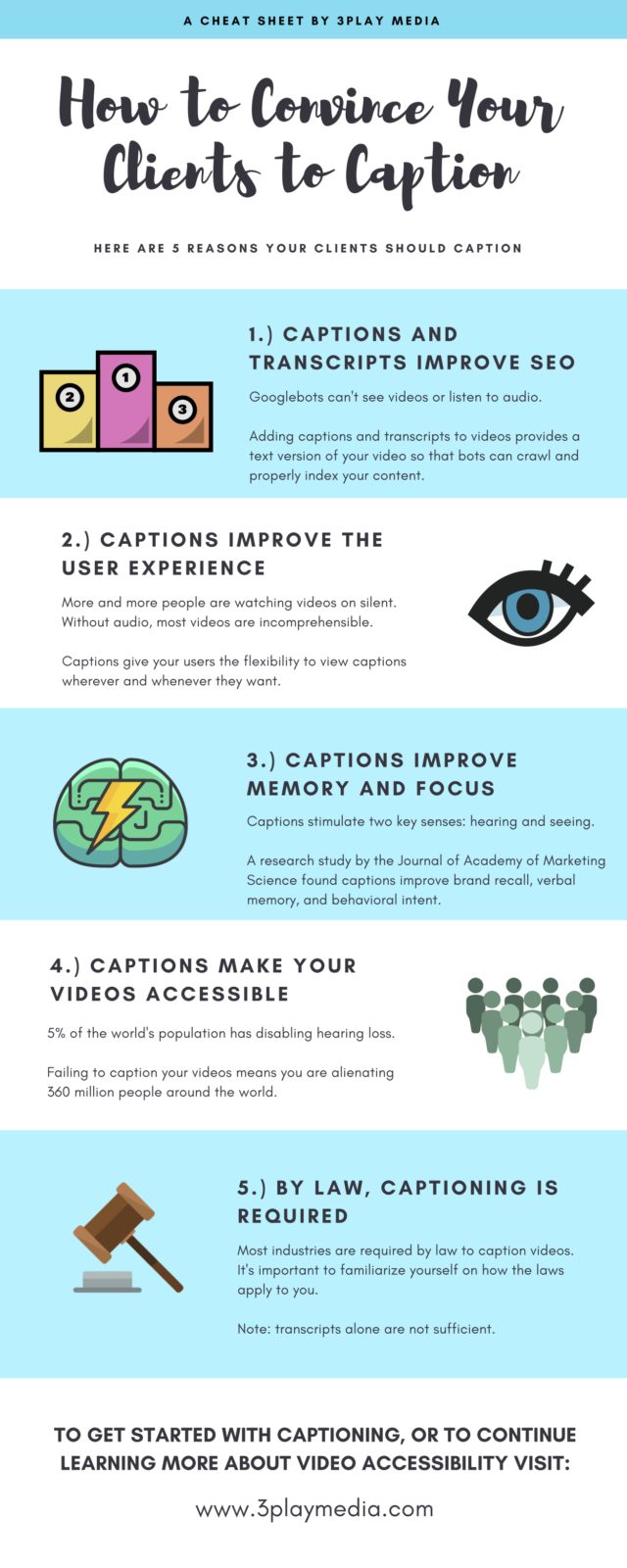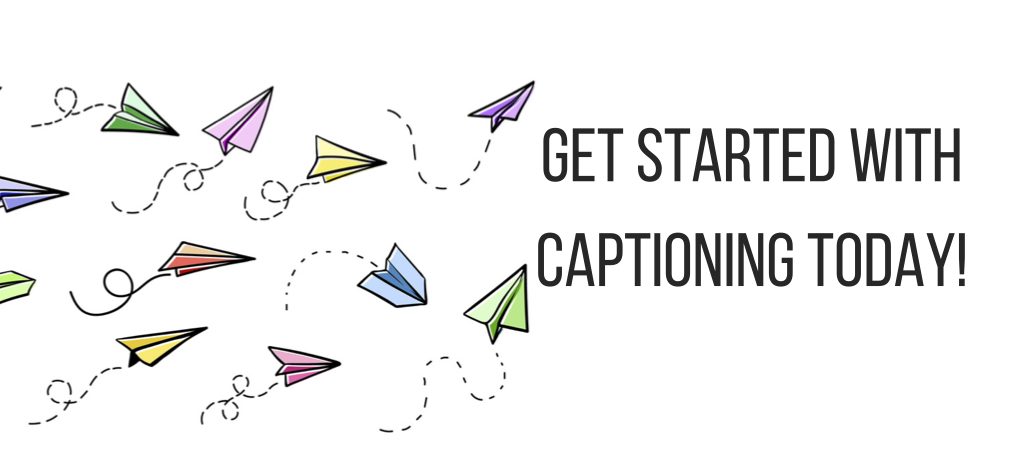How to Convince Your Clients to Caption Videos
Updated: August 25, 2023
Oh dear… you know it’s good for them, you know it will help them, yet your clients still don’t want captions.
How are you supposed to convince your client that you are [always] right?
You have to school them with the facts the benefits of closed captions
Fact one: Captions and transcripts help improve SEO.
Key points to school your clients:
- Google’s bots can’t rank videos without captions and transcripts.
- Captions and transcripts help videos rank higher for more diverse keywords.
Google has these crawling creatures called Googlebots that are constantly indexing pages for Google.com.
Unfortunately, these bots can’t see video or listen to audio, so ultimately many videos aren’t indexed.
Fortunately, there is a workaround, and that workaround involves captions and transcripts!
Adding captions and transcripts to videos provides a text version of your video so search engine bots can crawl and index your video accordingly.
The result is increased search traffic because search engines are properly indexing your videos, as well as higher rankings because you’re also ranking for more diverse keywords.
And if you don’t want to add a transcript, you can always use 3Play’s SEO embed. This magical tool injects a hidden transcript into the head of your page so that it shows up in search engines, but not on your page. You can use this for videos hosted on YouTube, Vimeo, Wistia, Kaltura, Brightcove…you name it.
The selling point for your clients is this: “You’ve worked so hard to produce beautiful, informative videos. Yet, a title and description can only do so much in a world full of competing content. Adding captions and transcripts will help make your video more searchable, outranking the competition.”
Fact two: Captions improve the user experience.
Key points to school your clients:
- 80% of people who use captions aren’t d/Deaf or hard of hearing.
- Captions give viewers the flexibility to enjoy content wherever, uninterrupted.
- Facebook noticed a 12% increase in video view time when captions were added.
80% of people who use captions aren’t d/Deaf or hard of hearing.
See, captions (when available) are dependable. When you are in a noisy spot, like at an airport or at a bar, and you want to watch a video, having captions allows you to enjoy that video without needing headphones.
Or when you are at a quieter spot, like at the library or at work, you can still enjoy videos without the need for sound.
With captions, viewers can easily grasp the content of the video – after all, most videos are incomprehensible without sound.
To make the case for captions even stronger, Facebook uncovered that 80% of viewers react negatively to videos autoplaying with sound. In response to these findings, they made the executive decision to auto-play videos without sound.
So if your videos rely on sound, you can expect to have a lot of people skip over them if they don’t have captions.
Through the addition of captions, Facebook noticed a 12% increase in video view time.
The simple truth is captions make people stop, read, and pay attention.
The selling point for your clients is this: “People are consuming content constantly, thanks to the smartphone. Adding captions gives people the flexibility to view your video whenever and wherever they want. It also ensures that your videos don’t receive the dreaded ‘thumb pass.'”
Fact three: Captions improve memory and focus.
Key points to school your clients:
- Captions have been proven to improve brand recall, verbal memory, and behavioral intent.
Captions make it easier to follow along with the audio.
Like magic, captions instantly engage your audience because they stimulate two key senses: hearing and seeing.
Are you one to take notes while listening to a lecture or seminar? Isn’t it infinitely easier to recall information when you have it written down or when you are seeing it?
Science can prove this.
A research study by the University of Iowa found people recalled information better after seeing it.
That is why captions can be so powerful: they visually represent the audio.
And, as an added bonus, they also help with memory. In another study by the Journal of the Academy of Marketing Science, they found captions improve brand recall, verbal memory, and behavioral intent.
So, here is the selling point for your clients: “Adding captions to your videos will not only engage and focus your audience, it will also improve brand recall.”
Fact four: Captions make your videos accessible.
Key points to school your clients:
- Captions make your video accessible to the d/Deaf and hard of hearing population.
Over 5% of the world’s population has disabling hearing loss.
Captions alone could help make videos more accessible to those 360 million people.
The disappointing truth is that much of our web is not accessible, especially when it comes to video.
This is unfair because everyone should have access to all the content on the web. Plus, wouldn’t you want your content to reach as many people as possible?
Adding captions will broaden your audience.
So, here is your selling point for your clients: “Failing to caption means you are failing to reach 360 million viewers.”
Fact five: It’s the law.
Key points to school your clients:
- Know which accessibility laws apply to your client. Different industries have different requirements.
- Most laws require closed captions for video content – a transcript is not sufficient.
Depending on your client’s industry, they may be required by law to caption.
Laws that require closed captioning in the US include:
The Americans with Disabilities Act (ADA): applies to municipal and state offices and facilities; museums; libraries; schools, colleges & universities; theaters & cinemas; convention centers & arenas; train stations & airports; hotels; parks; hospitals and clinics; pharmacies; restaurants; retail stores & malls; day care facilities; online services or products that are made publicly available.
Section 508 and Section 504 of the Rehabilitation Act: applies to US federal offices and all their digital or physical services and communications; organizations that receive federal funding; universities or colleges that receive federal grants.
FCC Closed Captioning Regulations: applies to television broadcasters in the US; television content producers; television content distributors, online or analog; film producers and distributors in the US.
21st Century Communications and Video Accessibility Act (CVAA): applies to Websites that stream or offer downloadable English or Spanish video that previously aired on American television with captions.
State laws: some states have enacted their own “little 508s,” which requiring state government entities to comply with federal accessibility laws.
Make sure to check out our accessibility laws by industry section. We have a lot of resources regarding video accessibility around the world. You can also take the quiz, “What Captioning Laws Apply to You?”

Conclusion
Captioning is an important step in the video production process that shouldn’t be avoided. Captioning helps with SEO, viewership, brand recall, accessibility, and legal compliance.
Next time your client objects to captioning, you can use these facts to convince them otherwise!
And because infographics help with information retention, here is one to help you with all the juicy facts outlined above.


Further Reading

Subscribe to the Blog Digest
Sign up to receive our blog digest and other information on this topic. You can unsubscribe anytime.
By subscribing you agree to our privacy policy.







